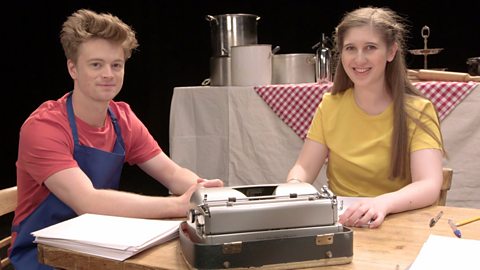What do English students and lawyers have in common?
They have to provide evidence to support their claims!
Introduction to how to use evidence from a text
Whenever you write about ideas presented in a text, you must provide evidence from that text to prove your point, explaining how and why the evidence you have provided demonstrates your claims – just like a lawyer does in court!
Video about how to use supporting evidence
Learn how to support your points with direct quotations or examples from a text
Using evidence
When writing about a text and the ideas it presents, it is important to support each of your claims with evidence from the text. This enables you to show how you have arrived at your conclusion – something you must do in order to make your analysis convincing.
Evidence can be:
Quotations from the text
For example:
Steinbeck describes Slim’s ‘godlike eyes’, which suggests his power and authority on the ranch.Examples from the text
For example:
The narrator is never named in Daphne du Maurier's novel Rebecca.
Both types of evidence must be relevant and support each idea you have about the text. They are used to help you prove your point showing the reader that what you say about the text is based on ideas presented in the text.
When you provide a direct quotationWhen you provide the exact words from the original writer, presented in quotation marks, to show it has come straight from the text., you must use quotation marksPunctuation marks (like speech marks - " or ') used to mark either the beginning or the end of a quotation. at the start and end of the quotation to show the reader that this evidence has been taken directly from the text.
The example below demonstrates how you might use evidence from The Art of Being Normal by Lisa Williamson:
David likens Harry to an angry animal by saying ‘he growls in my ear.’

Place the quotation marks
Look for the evidence taken from the text in the following sentence. Where you think the quotation marks should go?
Bruno’s maid, Maria, is clearly worried about something at the start of the novel as she was twisting her hands together nervously.
The Boy in the Striped Pyjamas by John Boyne
Answer:
Bruno’s maid, Maria, is clearly worried about something at the start of the novel as she was ‘twisting her hands together nervously’.
The Boy in the Striped Pyjamas by John Boyne
Selecting relevant quotations
In order to select the most appropriate quotation as evidence you need to ensure it is:
- Relevant to the claim you are making about the text.
- Implying the ideas you are saying the text is presenting (rather than stating them directly).
- The best piece of evidence to prove that the writer is implyingCommunicating something through suggestion rather than directly stating it. these ideas.
In Trash, by Andy Mulligan, sections of the story are narrated by the character Raphael, who is homeless and lives on a rubbish dump. He needs to be smart and resourceful to survive. When you read about his character you might conclude that he seems sneaky or devious at times. One way to show this is to select a part of the text that you think implies and best supports your ideas. For example:
Raphael seems sneaky and devious because he took a map of the city and ‘slipped it down’ his shorts rather than share his find with others.
Using the direct quotation, ‘slipped it down’ shows that you have:
- Looked at this part of the text carefully.
- Thought about how Raphael’s actions have been described and what it implies about the character.
- Used the descriptions of Raphael’s actions to form a view of the character.
Before selecting a quotation to prove a point, think about what makes it relevant. A relevant quotation demonstrates your idea – it should be closely connected to the point you are making.

Pick the most relevant quotation
Read the following claim about the lift Thomas wakes up in at the start of The Maze Runner by James Dashner.
The lift that Thomas first wakes up in doesn’t sound very safe and seems frightening.
Now, read the extract and decide which the part of the text that you think would best be used as evidence for this claim.
The lightless lift swayed back and forth as it ascended, turning the boy’s stomach sour with nausea; a smell like burnt oil invaded his senses, making him feel worse. He wanted to cry, but no tears came; he could only sit there, alone, waiting.
Answer:
'The lightless lift swayed back and forth' – this is a good quotation to pick! The fact that it is swinging ‘back and forth’ implies that the lift is unstable and therefore unsafe and the lack of light makes it sound even more frightening.
'A smell like burnt oil' – this could also work as evidence for the claim, as it hints at something potentially being wrong with the lift, which would be frightening.
Embedding quotations
When providing evidence for a claim you make about the text you are analysing, it is important to try and embed your quotation to make it a seamless part of your own sentence, like this example that uses evidence from The Art of Being Normal by Lisa Williamson.
Try to intergrateTo combine two things together so that it becomes one. the evidence into your explanation.
Instead of saying: David clearly thinks Harry is like an angry animal and feels threatened by him. This is shown when it says ‘he growls in my ear’.
Embed the quotation: When Harry ‘growls in’ David’s ear, it is clear David feels threatened by him as he is behaving like an aggressive animal warning David he might attack.
Helpful hints
Hint 1: To successfully embed quotations into your sentences, only quote the important key words or phrases.
Hint 2: If you need to change the tense used in your chosen quotation so that they make grammatical sense in your sentence, you can. To do this, use square brackets to show you’ve changed the endings of key words. For instance:
When Harry ‘growl[ed]in’ David’s ear, it was clear David felt threatened by him as he was behaving like an aggressive animal warning David he might attack.
Remember: don’t forget to still use quotation marks around the words or phrases you have taken directly from the text to show they are not your own words!
Expanding and developing your point
After you have used evidence to prove your point, move on and expand your idea further. This doesn’t just involve explaining what the quotation means and how it has been used to imply the point you are making – it involves developing your first point further.
Let’s look at the description of the jungle in Lord of the Flies by William Golding, analysing what is being implied about it:
When the boys’ plane crashes into the ‘bath of heat’ that is the jungle, it is instantly made to sound unpleasant and intolerable.
This could be expanded on by explaining why the phrase ‘bath of heat’ implies these ideas, identifying and explaining any language techniques that the writer may have used. For instance:
This metaphor makes it sound unbearably hot with no let-up – like you are surrounded by heat in the way you would normally be with water in a bath.
You could then develop this further still by providing additional evidence, in the form of a secondary quotation, that adds more relevant ideas about the jungle. For instance:
The fact that the boys were ‘caught and scratched by thorns’ further adds to the impression that the jungle is inhospitable and unwelcoming.

Try expanding your point
Here is a claim, with supporting evidence, about an old dog in the novella Of Mice and Men by John Steinbeck:
Candy’s dog is clearly nearing the end of its life as it is ‘gray of muzzle’, implying it is old.
Use this secondary evidence to expand on the above, developing the point about why we know the dog is probably not going to live for very much longer.
The dog struggled lamely to the side of the room and lay down, grunting softly to himself and licking his grizzled, moth-eaten coat.
One possible answer is:
Candy’s dog is clearly nearing the end of its life as it is ‘gray of muzzle’, implying it is old. It also has a ‘moth-eaten coat’ and ‘struggle[s] lamely’ to walk which further suggests that it is injured or not very well.
Test your knowledge
GCSE exam dates 2025
Find out everything you need to know about the 2025 GCSE exams including dates, timetables and changes to exams to get your revision in shape.

More on Essay writing
Find out more by working through a topic
- count2 of 5

- count3 of 5

- count4 of 5

- count5 of 5
